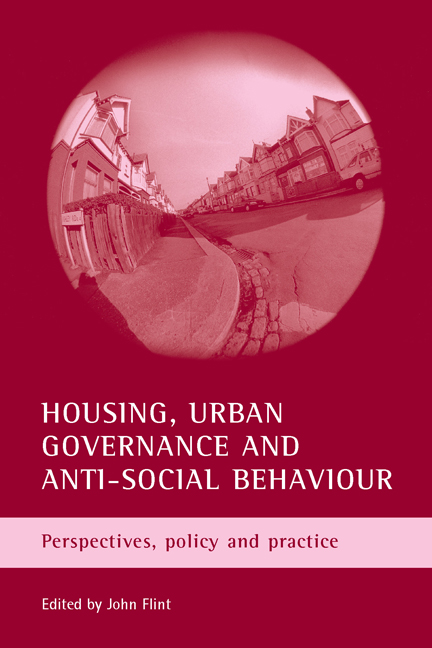Book contents
- Frontmatter
- Contents
- List of tables, figures and photographs
- Acknowledgements
- Notes on contributors
- Introduction
- Part 1 The definition and construction of anti-social behaviour in the UK
- Part 2 Legal techniques and measures utilised by social landlords to address anti-social behaviour
- Part 3 The emerging mechanisms of addressing anti-social behaviour in housing governance
- Part 4 Studies of housing and anti-social behaviour from an international perspective
- Index
twelve - Gated communities: a response to, or remedy for, anti-social behaviour?
Published online by Cambridge University Press: 15 January 2022
- Frontmatter
- Contents
- List of tables, figures and photographs
- Acknowledgements
- Notes on contributors
- Introduction
- Part 1 The definition and construction of anti-social behaviour in the UK
- Part 2 Legal techniques and measures utilised by social landlords to address anti-social behaviour
- Part 3 The emerging mechanisms of addressing anti-social behaviour in housing governance
- Part 4 Studies of housing and anti-social behaviour from an international perspective
- Index
Summary
Introduction
Gated communities1 hold out the promise of a sanitised residential cocoon, from which anti-social behaviour (ASB) can be excluded if perpetrated by outsiders, or controlled through internal regulation if residents are involved. This chapter examines the validity of this promise and how gated communities, which are increasingly seen in areas of social rented housing as well as in affluent private housing neighbourhoods, fit within the current government policy agenda, which positions housing in general as central to neighbourhood renewal. The privatised and collectively managed space of gated communities seems to foreshadow the devolved neighbourhood governance and community ownership of housing described by John Flint in Chapter One (this volume), which are currently being promoted through the stock transfer programme and other initiatives.
This chapter examines whether the physical and sociolegal features of gated developments can contribute to community capacity, and explores the implications of the legal framework that sets clear rules for residents and gives them responsibility for managing their own development. It considers whether such features might beneficially be used in deprived neighbourhoods. Further, it considers whether gated communities might contribute to the aim of mixed communities by encouraging the ‘colonisation’ of primarily social rented areas by owner-occupiers. The chapter concludes by linking the focus on ASB with the wider implications of gated communities for fostering a socially inclusive society.
Gated communities
Gated community developments combine a particular sociolegal framework with a built form that denies or restricts public access to space such as driveways, internal roads and grounds around buildings, which non-residents would usually expect to be able to walk or drive through. Buildings such as a block of flats, where public access is restricted only at the front door, for example, by means of a concierge or entryphone system, therefore do not fall within this definition of gated community. It is also important to distinguish between two kinds of gated community. One type is an existing neighbourhood which is subsequently gated by, or at the request of, its residents. Barriers are erected across the public access roads and a boundary is built around the neighbourhood. This type of gated community is common in South Africa, for instance, where some neighbourhood enclosures are blatantly unlawful while the local authority sanctions others.
- Type
- Chapter
- Information
- Housing, Urban Governance and Anti-Social BehaviourPerspectives, Policy and Practice, pp. 239 - 256Publisher: Bristol University PressPrint publication year: 2006



